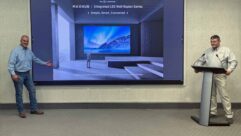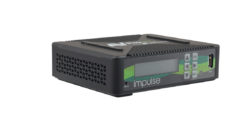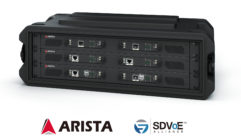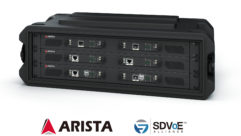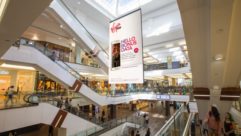
Installation Profile:
Delivering the Message
Mar 1, 2006 12:00 PM,
By Bennet Liles
Commitment and interactive AV at the core of Cisco’s Executive Briefing Center.
Cisco’s renovation of its Executive Briefing Center combines a traditional conference setting with a fun, interactive environment where visitors can browse the company’s message at nine display clusters.
In world-class corporate competition, you keep pace or die. Field leaders have been powered by two proven success engines. They effectively communicate what their company has to offer and then they seed and nurture profitable client relationships. At Cisco Systems, a leader in Internet communication technology, a dazzling array of new interactive AV systems in its Executive Briefing Center (EBC) leaves clients with no doubt as to what the company can do for them.
This goal of using modern tools to present its modern product offerings created both a challenge and an opportunity when the company chose to renovate the six-year-old center and install the latest AV technology to greet the more than 15,000 clients who converge on the San Jose, Calif., facility yearly to learn how Cisco can help them lead their fields in the Internet economy. But to Dora Hamilton, Cisco’s senior manager for worldwide briefing programs, this goal extended far beyond the EBC’s walls.
“A lot of our customers who don’t travel come to us through videoconferencing. We wanted to have state-of-the-art videoconferencing because we see that as more and more the way of doing business.” Effective communication is a two-way street and to those who come the EBC, the experience transcends classroom lectures.
“One of the purposes of the renovation was to provide a more interactive environment for our customers,” says Hamilton. “A good portion of the day is spent in conference rooms with discussion leaders so our goal was to create an environment for our customers to get out of the room and learn about Cisco and our solutions through an interactive and fun experience.”
The plan involved 17 conference rooms surrounding a glass-enclosed circular demonstration core. Splitting the circle, a central control room was designed to house the audiovisual equipment racks. An open area between the conference rooms and the demonstration core contains nine interactive display clusters with a variety of screen types and spacing arrangements. These are used primarily to greet clients with attractive presentations of the company message.
Digital media services company Downstream of Portland, Ore. was commissioned as the concept design firm, and Downstream’s president, Tim Larson, worked closely with Cisco to turn the company’s vision into a workable reality.
“We had the experience with sound and video integration and distribution,” Larson says, “but the unique thing about this job was the degree of control switching there was to accomplish. We had to use a technical integration outfit that we felt was capable of handling the substantial control switching concept.”

Presenters can make the control room a demonstration tool using LCD glass panels that allow them to selectively highlight specific racks of Cisco equipment.
From five companies submitting bids for the AV work, Avidex Industries of Redmond, Wash., was chosen for the job. The company’s first challenge was having barely two months for construction and installation! How do you get such a huge job done on time and not end up with sound blasting from bathrooms and water spraying from speakers? Avidex’s first objective was to assemble a first-rate, dedicated team to see the project through to completion. Steve Porter, the Avidex account manager, joined with Dan Graham, the project manager, and Scott Fillingham from Pacific Interactive. Avidex staff assigned Constantine Zachariou the key role as the technical director, supervising the onsite AV integration team and all aspects of the work. The incredibly short timeline required the project to be planned and executed with the precision of a commando operation.
“The schedule was insane,” Zachariou recalls. He had to know which techs were good at what job, make sure they got it done on time, and then move them to the next. “I’ve never done a $3 million project in three months,” he says. “It was a continual juggling act.”
The facility’s two networks are linked by Pacific Interactive servers. “The main server is dual NIC and sits across both the Cisco corporate network and the private AV network,” Fillingham explains. “In that way, any computer on Cisco’s world network can see and activate the commands of that center if it is authorized to do so, without the AV components themselves being exposed to the network and the security issue. Every device in the facility can be controlled from any computer in the building. It’s not a wide-open arrangement, but it can be flexibly configured in any way.”

Rear view of the wiring for the Extron 128×128 RGBHV with stereo audio matrix switch used in the Cisco Executive Briefing Center.
CONFERENCE ROOMS
In each conference room there are two InFocus LP-850 projectors and two side-by-side wall-mounted Stewart Luxus screens with Ultramatte 150 flexible screen material. The projector inputs are fed by an Extron 8×4 MVX 84 VGA switcher. For videoconferencing, two RS-232-controlled Sony EVI-D70 cameras are mounted at the front and rear of the room. Sound is picked up through ceiling-mounted Beyer SHM22 microphones connected by Belden 82761 cable to a ClearOne XAP-400 conferencing controller. From there they go to local amplifiers and to the main facility controller via Extron Cat-5 transmitter/receiver baluns. DMX radio is also routed through the XAP-400 to four in-wall speakers. Local control is provided by custom-designed Pacific Interactive software displayed on a Smart Technologies Sympodium.
“The Sympodium plugs into the laptop,” Fillingham explains. “The laptop runs their PowerPoint and other presentation software, and our toolbar sits at the top, auto-hides, and shows up when they move their pen up to the top of the screen to give them access to the typical control room functions: the projector, drapes, lights, and so on. The design of that application was based on interviews with the presenters themselves.” In keeping with the intense timeline, the software had to be developed quickly, and Pacific Interactive played its ace-in-the-hole for this.
“Our EC series is a software framework for creating custom applications without going through what you would normally have to do to make a custom application,” Fillingham says. “Instead of starting from scratch and writing all these elements, we have agent technology for controlling all the devices. We have tools that generate a lot of the logic for you. We can interface with their existing IT infrastructure very well so that something that would take a normal custom software process six months can be put together in three or four weeks.”
Zachariou outlines the signal path. “The control laptop lives on the Cisco production network and detects commands from the presenter,” he says. “It talks to the PI server, which in turn talks to the AV network, which sends whatever command to a specific device. If the user selects ‘zoom in front camera’, that command goes out over the laptop in the room to the PI server, over to the AV network, and from there, via RS-232 on the camera, it executes that command.”
There is a shared videoconferencing pool with Tandberg 6000 codecs that sit in a central location. A user interface allows each codec to be reserved for a room for a period of time. The room takes local control of that codec until its reservation expires. It helps AV helpdesk technicians to be able to actually see individual callers’ situations, so Cisco technicians use Axis 213PTZ IP cameras strictly for room monitoring.
“They don’t connect to the AV system at all,” Zachariou explains. “They go straight out through the Cisco network, and the people in charge of the facility can, through a password-protected web page, see and hear what is going on.”
DEMONSTRATION CORE
The central Demonstration Core allows the latest Cisco technology to be showcased in an interactive environment where clients are provided the maximum experience with both the form and function of the company’s products. This circular, glass-enclosed section houses a control room along the center diameter flanked by a demonstration area on either side and separated from these by LCD glass panels. Among the 9ft. control room racks is the Raritan Paragon II 128×64 KVM switching system, which provides keyboard, mouse, and video control of up to 128 servers from up to 64 user locations around the facility. Each demo room has RGBHV and stereo audio connectivity to and from these switching matrices through UTP cable on Extron Cat-5 baluns.
Zachariou’s team relied heavily on these. “There are some 330 Extron baluns,” he notes. “We tested them, and we had a lot of support from Extron. From the time we began testing, we had only three or four that failed. We replaced those, and we haven’t had any issues since. One of the challenges and the reason why the design happened using Cat-5 baluns was due to the space limitations up in the ceiling. Cisco has all their networking infrastructure up there, so to be running big thick RGBHV cables, audio cables, and RS-232, you would have had gigantic bundles. The furthest we go is about 350ft. to 400ft. on Cat-5. All our stuff is navy blue, so the Cisco people can stay away from it.”

Each cluster has its own control server that is connected by RS-232 to the touchpanel for the cluster. When the server detects a push, it actuates the other servers to play a specific show.
THE MAN BEHIND THE CURTAIN
At the Cisco EBC, you actually do pay attention to the man behind the curtain or, in this case, to the gear behind the screen. The LCD glass panels separating the demo areas from the control room can serve as screens for 11 NEC GT6000 projectors one moment and then, on command, turn transparent to showcase a specific rack of Cisco equipment in the control room behind them.
Fillingham explains how this visual wizardry works. “They basically act like light, and so you put them on a dimmer. You make a lighting adjustment, and they follow along. We control them via the Lutron to make them transparent or opaque. It’s done through the Lutron because we also control the lighting in the demo core for their shows.”
Presenters are provided a variety of tools with which to express their creativity. They can create buttons on a wireless tablet PC and put actions on those buttons. As they walk around the demonstration area with their 802.11 tablet, they just hit the next button to advance through their presentation.
“In the demo core, they need to be able to set up these demonstrations where the glass goes opaque, and they project on them,” Fillingham says, “and then they want to expose the fourth rack from the right and put lights on it at some point and talk about that.”
“All we’re doing is controlling them with relays,” Zachariou adds. “Their normal off-state is opaque. In that state we’re using them as projection surfaces. Then, when the panels are energized, they turn clear so that clients can see the Cisco racks behind the glass.”

Each conference room features two InFocus LP-850 projectors and two side-by-side wall-mounted Stewart Luxus screens with Ultramatte 150 flexible screen material. A Smart Technologies Sympodium is equipped with custom-designed Pacific Interactive software.
DISPLAY CLUSTERS
While taking a break from conferences and demonstrations, clients can browse among nine display clusters in a walk-around area. These are used to enhance delivery of the company’s message.
“We wanted to present the Cisco messaging and story in a very visual and appealing way,” Dora Hamilton says, “so that when our customers come, they learn about Cisco and our core values. To this end we developed nine areas with interactive videos that focus on educating our customers about Cisco’s vision and presence in the industry.”
Using Clarity Visual Margay and Bobcat LCD screens, NEC 61in. and 50in. plasma displays, NEC GT6000 projectors, and Sony Luma series 23in. and 17in. LCD screens, the display clusters are fed via UTP cable from dedicated media servers in the central control room. The seating section of each area presents a touchpanel used to select video-on-demand clips. Along the building corridors, there are eight isolated Clarity Bobcat LCD displays, ensuring that no area of the facility is message-dark.
There is one area called “distinguished engineering fellows,” where users can operate the touchpanel controller to watch bios of well-known Cisco engineers. In another display cluster, there are customer testimonials, and a viewer can select and view a little show from different clients for whom Cisco has installed large systems. Each of these displays has a dedicated server, and there is a control server for that specific cluster. The touchpanel for the cluster is connected by RS-232 to the control server so that when the server detects a push, it actuates the other servers to play a specific show. The displays can be arranged in a group that is contiguous or spaced, vertical, horizontal, or angled. Presentations can include projected images that can be overlapped and blended to create stunning, seamless panoramas.
As the installation leader, Zachariou is pleased with the results. “We have not had any interference issues,” he notes happily. “All the displays, the NEC plasmas, and the Clarity Margays are getting their signals over Cat-5, and they look great.”
All of the cluster displays are coordinated with Dataton’s Watchout software, which can generate the native resolution of each display to provide optimal picture clarity. If a specific display device is 1280×1024 pixels native, Watchout will output 1280×1024 resolution, relieving the display device from scaling and potentially degrading the picture.
The display graphics are easily created with off-the-shelf applications like Photoshop, After Effects, or various video editing packages. Watchout accepts virtually all standard bitmap and motion media file formats and then lets the programmer organize the presentation flow, movement, and timing using a timeline layout for drag-and-drop insertion and layering of media files. The clusters can be expanded by simply adding another display device and a control computer to drive it. The displays may be projectors, CRT or LCD screens, plasmas, LED walls, videowall cubes, or televisions. The central production computer drives all of the display control computers. Watchout can play video with resolution up to HD video in 1920×1080 or Windows Media files.
The common network for all these displays can be used with an external controller for scheduling shows, presentation-on-demand, and random playback of items from a list of program content.
Lighting within the AV exhibit areas was created with indirect, color-changing LED light coves at the ceiling, combined with light-diffusing ceiling baffles that provided a ceiling canopy over each exhibit area. The exhibit areas were further defined through the use of “floating” light fixtures that were suspended between the floor and ceiling and located behind each seating area.
For large gatherings, there is also a multi-purpose room used primarily as a meeting or dining room. Two projectors on motorized lifts are installed here, along with a voice reinforcement system and ceiling speakers for delivering program sound. Videoconferencing is also available in this room through wireless microphones, ceiling mics, and four ceiling-mounted cameras. These are also connected through the centrally located switching matrices and codecs in the control room.
As impressive as the technology is, the truly fantastic aspect to this job is how it all came together on such a brutally short schedule. The various construction trades were working multiple shifts 24 hours a day. Frequent meetings between the client, the project team, and the trades were necessary to maintain coordination and keep the project on track.
“None of us had heard of it in November,” Fillingham recalls, “and they opened the doors in March.”
According to Zachariou, he was totally absorbed at the site. “I spent from Jan. 3 through the end of March living at Cisco and working virtually around the clock. The whole floor was torn out and built back from scratch,” he notes. “The entire team went anywhere from 10 to almost 30 people at times, just for AV. The general contractor was Devcon Construction. They handled most of that coordination, and they did a phenomenal job.”
But, as always, the primary objective is that the client is pleased. “We’ve been very pleased with the system and have received very positive feedback from our customers,” Hamilton remarks. “Avidex is continuing to maintain the system for us, and they are doing a great job.”
This is just what Downstream’s Tim Larson was hoping to hear. “We wanted to put a system in place that would not only provide a first-rate demonstration capability for Cisco’s products but also allow the company to tell its story in a way that is meaningful and engaging.”
The Cisco EBC renovation project has demonstrated that even on a crash schedule, when construction crews, AV systems integrators, and custom software developers practice close communication and use a solid plan, miracles can happen.
For More Information
Avidex
www.avidexav.com
Axis Communications
www.axis.com
Belden CDT Electronics Division
www.belden.com
Beyerdynamic
www.beyerdynamic.com
Cisco Systems
www.cisco.com
Clarity Visual Systems
www.clarityvisual.com
ClearOne Communications
www.clearone.com
Dataton
www.dataton.com
Extron Electronics
www.extron.com
InFocus
www.infocus.com
Lutron Electronics
www.lutron.com
NEC Visual Systems
www.necvisualsystems.com
Pacific Interactive
www.pacint.com
Raritan Computer
www.raritan.com
Smart Technologies
www.smarttech.com
Sony
www.sony.com
Stewart Filmscreen
www.stewartfilmscreen.com
Tandberg
www.tandberg.net


